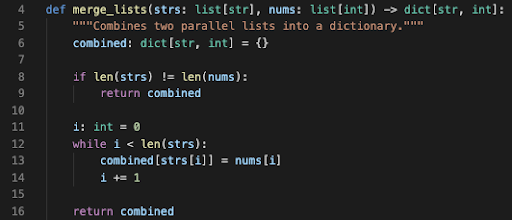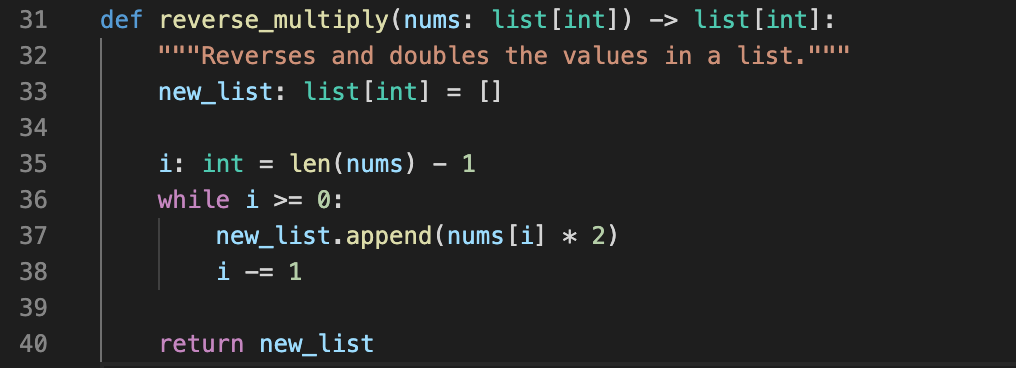The final exam only includes one new concept: recursion! We will be adding practice recursive memory diagrams to the practice memory diagram page soon! You also should make sure you are more comfortable with nested data structures (e.g. lists of dicts), as that’s what we worked on with DataWrangling!
Otherwise, to practice, you should review the practice problems for the previous quizzes:
Additionally, you will be expected to do more advanced function writing for the final, so we’ve included more function writing practice problems below.
Questions
This review is not comprehensive of all content that will be on the final exam, but rather provides a few extra practice questions. Previous quizzes/practice questions are also valuable in reviewing for the final exam. Lecture videos are another valuable resource.
Solutions for each problem can be found at the bottom of this page. Keep in mind that there may be multiple solutions to each problem.
Function Writing
Write a function called
free_biscuits. Given a dictionary withstrkeys (representing basketball games) andlist[int]values (representing points scored by players),free_biscuitsshould return a new dictionary of typedict[str, bool]that maps each game to a boolean value for free biscuits. (Trueif the points add up to 100+,Falseif otherwise)
Example:free_biscuits({ “UNCvsDuke”: [38, 20, 42] , “UNCvsState”: [9, 51, 16, 23] })should return{ “UNCvsDuke”: True, “UNCvsState”: False }.Write a function called
max_key. Given a dictionary withstrkeys andlist[int]values, return astrwith the name of the key whose list has the highest sum of values. Example:max_key({"a": [1,2,3], "b": [4,5,6]})should return"b"because the sum ofa’s elements is 1 + 2 + 3 = 6 and the sum ofb’s elements is 4 + 5 + 6 = 15, and 15 > 6.Write a function called
multiples. Given alist[int],multiplesshould return alist[bool]that tells whether eachintvalue is a multiple of the previous value. For the first number in the list, you should wrap around the list and compare thisintto the last number in the list. (Hint:xis a multiple ofyif and only ifx % yis0.) Example:multiples([2, 3, 4, 8, 16, 2, 4, 2])should return[True, False, False, True, True, False, True, False].Write a function called
merge_lists. Given alist[str]and alist[int],merge_listsshould return adict[str, int]that maps each item in the first list to its corresponding item in the second (based on index). If the lists are not the same size, the function should return an empty dictionary.
Example:merge_lists([“blue”, “yellow”, “red”], [5, 2, 4])should return{"blue": 5, "yellow": 2, "red": 4}.Write a function called
reverse_multiply. Given alist[int],reverse_multiplyshould return alist[int]with the values from the original list doubled and in reverse order.
Example:reverse_multiply([1, 2, 3])should return[6, 4, 2].
Solutions
Function Writing
def free_biscuits(input: dict[str, list[int]]) -> dict[str, bool]:
"""Check each game to see if we get free biscuits."""
result: dict[str, bool] = {}
# loop over each key in my input dictionary
for key in input:
# for each element of the dictionary, sum up its values
list_to_sum: list[int] = input[key]
sum: int = 0
# loop through list and add each value to sum
for element in list_to_sum:
sum += element
# if sum >= 100, store in result under key "key" with value True
if sum >= 100:
result[key] = True
else: # if not, store as False
result[key] = False
return result def max_key(input: dict[str, int]) -> str:
# Create variables to store max key and max val sum
max_key: str = ""
max_val_sum: int = 0
# Loop through each key of the dictionary
for key in input:
# Sum up the values of that key's corresponding list
val_sum: int = 0
for value in input[key]:
val_sum += value
# If the sum is the max so far, update the max_key and max_val_sum
if val_sum > max_val_sum:
max_val_sum = val_sum
max_key = key
return max_keyOne Solution:
def multiples(input: list[int]) -> list[bool]:
"""Return a mapping of each element for whether or not it's a multiple of the previous element"""
# initialize the output
output: list[bool] = []
# handle the "wrap around" case to check if the first element is a multiple of the last element
if input[0] % input[len(input) - 1] == 0: # If first element is a multiple of last
output.append(True) # Append True
else:
output.append(False) # Otherwise, append False
# now, handle the rest of the list
# for idx values 1 to len(input) - 1...
idx: int = 1
while idx < len(input):
# ...we want to see if val at idx is a multiple of val at idx-1
if input[idx] % input[idx-1] == 0:
output.append(True)
else:
output.append(False)
idx += 1
return outputAnother Solution:
def multiples(input: list[int]) -> list[bool]:
"""Return a mapping of each element for whether or not it's a multiple of the previous element"""
# initialize the output
output: list[bool] = []
# handle the "wrap around" case to check if the first element is a multiple of the last element
output.append(input[0] % input[len(input) - 1] == 0)
# now, handle the rest of the list
# for idx values 1 to len(input) - 1...
idx: int = 1
while idx < len(input):
# ...we want to see if val at idx is a multiple of val at idx-1
output.append(input[idx] % input[idx-1] == 0)
idx += 1
return output
